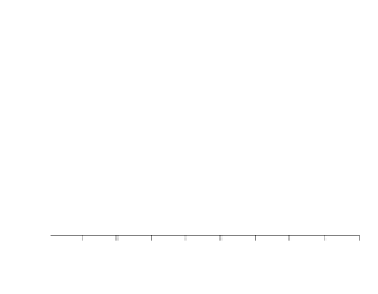Environmental Engineering Reference
In-Depth Information
samples saturated at a much lower level than that of the control and that a higher
irradiance is required to obtain half maximum response. This indicates a reduced light
sensitivity in irradiated samples.
8
7
6
5
4
3
2
1
0
0
10
20
30
40
50
60
70
80
Light fluence rate [W/m
2
]
Fig. 11.
Dose effect curves of the phototactic sensitivity of
F. salina
cells before (circles) and after
(triangles) 30 min irradiation with polychromatic UV-B, UV-A and visible radiation. Phototactic
activity in arbitrary units is plotted as a function of the irradiance of the stimulating light at 600nm.
Both curves can be fitted by an hyperbolic function (p>95%).
Targets of UV-B radiation
It is well known that UV radiation can also affect living organisms by means of
photodynamic reactions
33
, in which the excitation energy absorbed by a chromophore
molecule is used by either of two different mechanisms, one involving oxygen (type II
photodynamic reaction), the other involving other acceptors of the triplet energy (type I
photodynamic reaction). Both mechanisms can destroy cellular components
34
.
However, photodynamic reactions are unlikely involved in the above-described
UV-B effects in
B. japonicum
and
F. salina
, where the target molecules could be
intrinsic components of the photoreceptor apparatus and/or the photosensory
transduction chain
18,19
. In fact, experiments on
B. japonicum
indicated that the effects of
UV-B radiation are about the same in both red and blue
B. japonicum
cells
18
, the latter
containing an oxidized, less phototoxic form of the pigment and not undergoing
photosensitized killing
35
.
Absorption spectra of agar suspension of
B. japonicum
cells were not
significantly different after irradiation with UV-B or visible light
18
(see Fig. 12).
Fluorescence spectra showed an increase of fluorescence quantum yield. In visible-
irradiated cells this was probably due to the extrusion of the pigment from the cell,
which occurs even in the presence of dim light to avoid the harmful consequences of
blepharismin-sensitized photodynamic reactions
36
. In UV-B-irradiated cells the
quantum yield increase could be due to a damage of the molecular environment of
blepharismin. These spectroscopic measurements seems to indicate that UV-B
irradiation does not cause a specific molecular transformation of blepharismin. This was
confirmed by recent time-resolved fluorescence measurements on
B. japonicum











































Search WWH ::

Custom Search